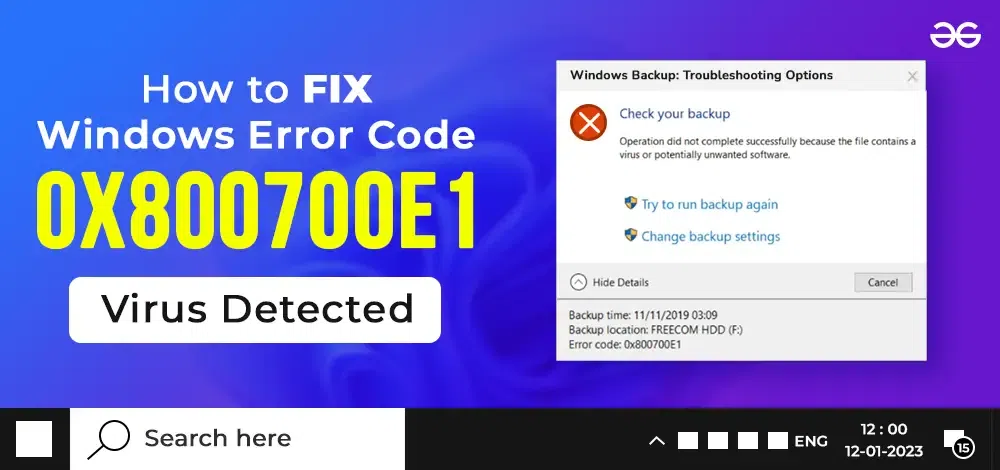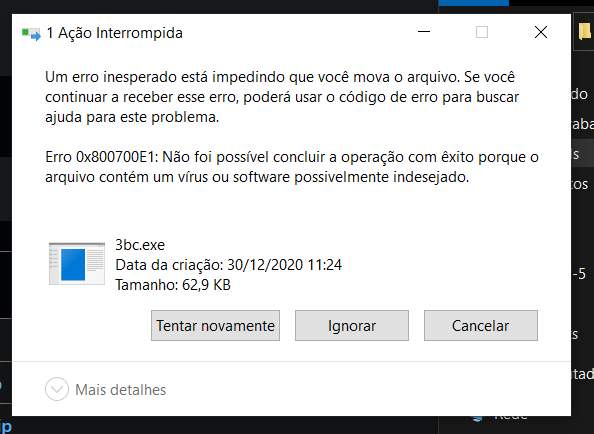Error code 0X800700E1 can frustrate anyone using Windows. It appears during software installation or file transfer.
Understanding this error is crucial for resolving it swiftly. Navigating Windows can sometimes lead to confusing error codes. Error 0X800700E1 often appears due to issues with antivirus software or corrupted files. It stops software installations, halts file transfers, and disrupts your workflow.
This error typically signals that Windows Defender or another security tool has flagged a file as potentially harmful. Resolving it requires identifying the root cause and applying the right fix. Whether you’re installing a new program or transferring files, knowing how to tackle 0X800700E1 can save time and hassle. In this guide, we’ll explore what causes this error and how you can troubleshoot it effectively. Understanding these steps helps ensure a smoother experience with your computer.
Common Causes Of 0x800700e1 Error
Malware can cause the 0X800700E1 error. They harm your computer system. Antivirus software helps in detecting them. Regular scans are crucial. Updates are also important. Outdated software might not detect new threats. Use trusted antivirus programs. Avoid unknown downloads. They might contain harmful files. Secure browsing reduces risk. Stay alert online. Cyber threats are everywhere. Protect your system from them.
Corrupted files lead to errors like 0X800700E1. They disrupt system processes. File corruption happens often. It can occur during downloads. Incomplete installations cause issues too. Always check file integrity. Use reliable sources for downloads. Back up important files regularly. This prevents data loss. Software updates fix bugs. Keep software updated for smooth operation. Avoid using outdated versions. They may not work well. Regular maintenance helps. Keep your system healthy.

Credit: www.geeksforgeeks.org
Initial Troubleshooting Steps
Restarting can solve many computer problems. Turn off your device. Wait a few seconds. Now, turn it back on. This can refresh the system. It clears temporary glitches. Restarting is a simple step. It often solves the error. Try it first. It works for many issues.
Viruses can cause many problems. Run an antivirus scan on your device. Make sure the antivirus is updated. Open the antivirus software. Select “Full Scan” option. This checks all files. Remove any virus detected. Keep your device safe. Regular scans are important. They help prevent errors.
Windows Defender And Firewall Settings
Sometimes, files get blocked by Windows Defender. This can cause errors like 0X800700E1. You may need to adjust security settings. Open the Windows Security app on your computer. Click on “Virus & Threat Protection”. Look for “Manage Settings” and click it. Here, you can change security settings.
To allow a blocked file, find the “Exclusions” section. Click on “Add or Remove Exclusions”. You can add files or folders here. Choose the file you want to allow. This tells Windows Defender it is safe. Remember, only allow files you trust. This keeps your computer safe from harm.

Credit: m.youtube.com
Using System Restore
A restore point is a snapshot of your computer’s settings. It helps when things go wrong. Open Control Panel and search for “System Restore”. Click on “Create a restore point”. Choose a drive and click “Create”. Name your restore point. This step is very important. It saves your computer’s state. You can go back to it later. Always make restore points before changes. This keeps your data safe.
Sometimes files get lost or changed. System Restore can help. It brings back older versions of files. Open “Control Panel” and select “System Restore”. Choose “Restore my computer to an earlier time”. Pick a date when things were fine. Click “Next” and follow the steps. Your computer will restart. It will bring back old files. This feature is helpful. It saves important documents and settings.
Updating Windows Software
Windows needs updates to work well. Click the Start button on your computer. Look for Settings and click it. Next, find Update & Security. Click on it. Now, you will see Check for updates. Click this button. Your computer will now look for updates. If there are updates, it will show you. Always make sure your computer is connected to the internet.
Found updates? Time to install them. Click on the Install button. Your computer will start downloading the updates. This might take some time. Do not turn off your computer during this. After downloading, it will install the updates. Sometimes, you might need to restart your computer. Always save your work before restarting.

Credit: www.youtube.com
Running System File Checker
Start by opening the Command Prompt. Make sure to run it as administrator. Type sfc /scannow and press Enter. The scan will begin checking your system files. This process ensures all files are correct. It may take some time. Be patient and let it finish. Do not close the window during the scan. Once completed, you will see the results.
After the scan, you will get a message. It tells if any corrupt files were found. If all files are good, no action is needed. Sometimes, the tool may fix errors by itself. If not, note the files that need repair. You might need extra steps to fix them. Always ensure your system is safe. Regular checks keep your computer healthy.
Cleaning Up Disk Space
Temporary files take up a lot of space. They often slow down your computer. Removing them frees up space. It also makes your computer faster. Check your computer for these files often. You can find them in the temp folder. Delete these files to save space. Some files might be important. Be careful when deleting them.
Disk Cleanup is a handy tool. It helps clean your computer. Open the tool from the start menu. Choose which files to delete. Temporary files and old downloads are safe to remove. Disk Cleanup also deletes system files. This can free up even more space. Always review files before deleting them. You don’t want to lose important data.
Seeking Professional Help
Facing the 0X800700E1 error can be confusing. Support services often provide quick solutions. They know the error code and can guide you. Describe the problem clearly. This helps them understand the issue faster. Keep all important information ready. Save time when explaining the issue.
Sometimes, a professional repair service might be needed. These experts can fix complex problems. Choosing a reliable service is important. Check reviews before making a choice. Good reviews mean they are trustworthy. Ask questions about the repair process. Understand what will be done to fix the error.
Conclusion
Fixing error 0X800700E1 feels tricky, but it’s doable. First, follow the steps outlined. Scan your computer. Remove any threats. Check your antivirus settings. Ensure updates are installed. This ensures smooth operation. Remember, regular maintenance prevents future issues. Keep your system clean.
Stay vigilant with security. Protect your data. A little care saves time and stress. No need for tech expertise. Just some patience and attention. Troubleshooting can be straightforward. With these tips, you can handle error 0X800700E1 confidently. Feel empowered to tackle tech challenges.
Stay informed and prepared.

Leave a Reply